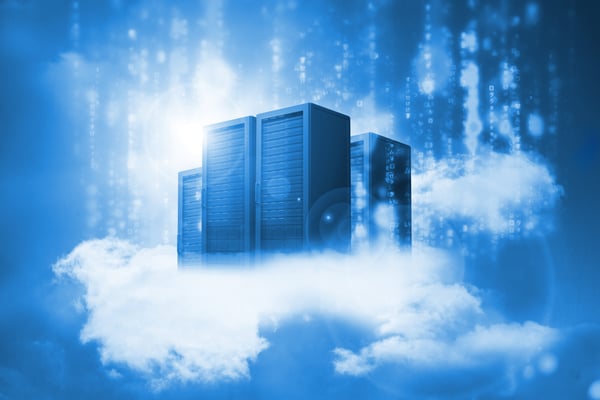What is a Cloud-based ERP Solution?
Technology is always evolving and sometimes it may be hard to catch up with all news and updates, in all different fronts covered by all technological improvements.
When it comes to ERP systems, the cloud buzz started years ago. We found ourselves facing many sorts of new acronyms, learn with all this and make good choices. Yes, sometimes it may be confusing since most articles explaining the cloud could go thru particularities of this new solution model without trying to demystify key concepts so we can go from there.
In a nutshell, the main question is to understand what is behind this cloud.
What is cloud-based?
To properly understand cloud, we should go from basics. The cloud concept can be applied to databases, hardware, middleware and software you may need to run your business or even in your personal life.
 If we take the business side of it, companies would choose systems to run operations, but they would start first by evaluating hardware requirements, meaning all equipment and infrastructure needed to have a proper environment, administration, back up and disaster recovery strategy in place to prepare the ground to host the application or software chosen. In the cloud world, this can start by the concept of colocation.
If we take the business side of it, companies would choose systems to run operations, but they would start first by evaluating hardware requirements, meaning all equipment and infrastructure needed to have a proper environment, administration, back up and disaster recovery strategy in place to prepare the ground to host the application or software chosen. In the cloud world, this can start by the concept of colocation.
The concept of colocation
Colocation is when the equipment or the hardware is owned by you and the service provider will offer the physical space and the facilities to host your equipment. In that model, you have your servers plugged using electricity, climatization and the suitable room in the service provider data center. You manage the hardware, middleware and software in all senses and requirements.
The infrastructure as a service (IaaS)
As a next step, we have the IaaS – infrastructure as a service. IaaS is the next level to the colocation. With IaaS, you don’t own the hardware, you provide specifications on how many servers and capacity you need to run your systems and you can create those environments, manage and upgrade them in the service provider platform. Pricing would be normally a function of the sizing and number of environments you need. This model is flexible as you need to increase your capacities as you go, which can be very interesting. It is also way better than buying a new server every couple of years to increase capacity and reinstalling all your operational systems, middleware, applications etc. In this model you are responsible for managing anything inside each environment as operational system installation and upgrades, middleware and applications. The service provider is responsible to guarantee service by having your environments up and running and all security to the data centers included.
The platform as a service (PaaS)
Evolving from the IaaS, we have the PaaS – platform as a service. The PaaS model is like the IaaS, but it includes the management of each environment, their preparation and their updates or upgrades to receive and run your applications. All operating systems and middleware required to run the applications are managed by the service provider in addition to the infrastructure services mentioned. This is advantageous because these providers will have scale in pricing and specialists dedicated to middleware, which will potentially reduce your needs to keep internal resources to do the environment administration, upgrades, compatibilities of versions etc.
The software as a Service (SaaS)
As a next level, we have the most popular component of this cloud family, SaaS – software as a service. SaaS is everywhere as a cloud model and sometimes it gets unnoticed to the users, and this is the idea. Facebook, Spotify, Netflix and some other well-known services are simple examples of SaaS. A solution, or software which is fully managed by its service provider. Updates are transparent to users and you pay for a service, requiring very low IT knowledge to manage this service for it to operate properly. The service provider guarantees full management of the application as well as the service level for performance.
If we take this now to the ERP world, where a solution is chosen to run operations end-to-end, cloud can be in all different models.
We will take a step back to talk about concerns in managing operations in the cloud, though.
What to consider when choosing a cloud ERP System?
There are a couple of attention points to consider when choosing a cloud ERP solution: Security, data access, data ownership terms, upgrades, service level, flexibility for customizations, technological platform and ownership costs.

1. Security
Obviously when we think that our business transactions will be hosted in a third-party server, security is the first concern that comes to our mind. Key software players keep the highest security standards when it comes to their data centers. Access to the data centers is normally highly secure, in a level you would not have in-house, from a physical perspective. From a technical perspective, barely no system in 100% safe from hackers, but be sure that a well-respected service provider should provide you server protection beyond any capability you could get in-house at a reasonable cost.
In that sense, look for contract terms demonstrating to which security standards their data centers comply to, like SSAE 16 or ISAE 3402.
2. Data access & ownership terms
The cloud service provider should also be able to offer a comprehensive contract term highlighting that your company is the sole proprietary of the data and the only entity authorized to provide any partial or complete release or access of your data. This should be standard and non-negotiable.
3. Upgrades & technological platforms
All upgrades should happen in a transparent way to users. The important point here is to guarantee that as you have the upgrades, any development particular to your company during the ERP or the solution implementation, would be preserved, regardless of the upcoming versions.
The cloud ERP or solution should equally offer you a technology platform allowing you to apply personalization to the environment as required and not to be a black box you cannot touch or understand how it works.
4. Flexibility and customization
Finally, the technological platform should be flexible and capable to allow for integration via web services, have APIs available, include workflows logic and tool and an IDE – integrated development environment which should allow you to design, configure and test your developments.
Evaluating the total cost of ownership of your ERP system
As you make sure the questions above are well answered and considering the cloud ERP or solutions you are evaluating respond to your needs, from a functionality perspective, we can think of costs, or better, the total cost of ownership (TCO).
 When you manage the systems in-house, you must account for facilities, hardware, middleware, software, licenses and IT personnel costs, not to mention backups and disaster recovery options.
When you manage the systems in-house, you must account for facilities, hardware, middleware, software, licenses and IT personnel costs, not to mention backups and disaster recovery options.
Redundancy and uptime bring a huge cost to your company and you must account for that when comparing on premises options to the cloud. A typical cloud ERP or solution should have a guaranteed uptime higher than 99%.
A local IT department is unlikely to be able to achieve these results and may not even be able to regularly report their system uptime results to management.
Have you already thought about how much it would cost you to keep your system up and running? Or worse, how much your business would lose on downtime of critical systems?
As per Gartner’s 2014 report on downtime costs, an average company loses $5 600.00 per minute of downtime of operation critical applications. Do the math. We should also account for the fact that Cloud ERPs or solutions would not offer the risk of loss of data if a downtime happens. This is also extremely relevant and costly in all senses, when we manage systems in-house, while application maintenance costs are increasing in a high rate, every year.
In general, the cost analysis bottom-line should be able to help you compare apples to apples.
In a first sight, you may find expensive to pay every year a given amount for as long as you have the cloud system running your operations, but when the proper comparison is done, under the same basis, costs per user for the cloud systems are roughly 50% of the total cost per user of an on premise system.
Every business is unique, and the choice of the most suitable cloud model or solutions should include the business priorities and particularities to ensure efficiency and the best fit.





